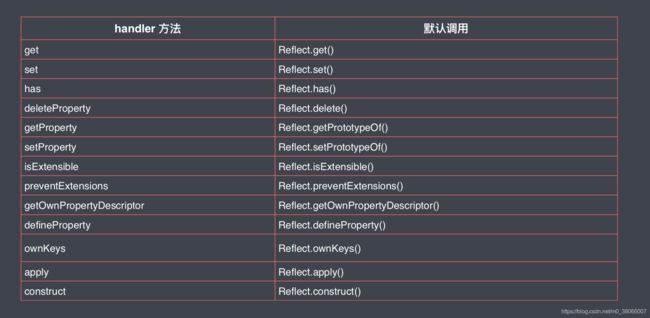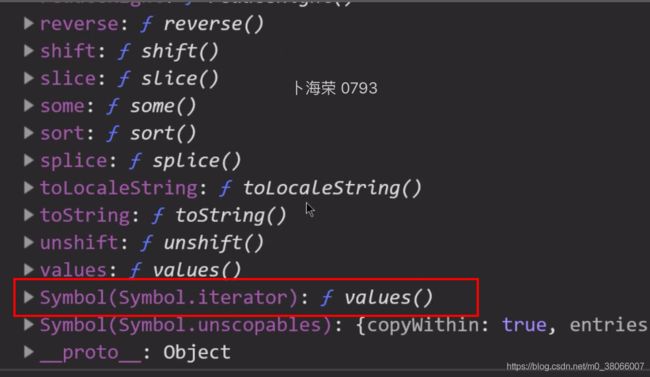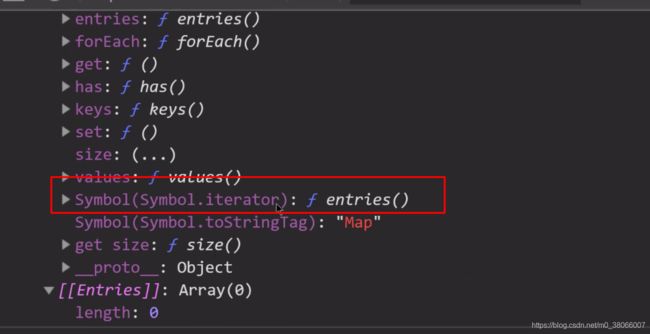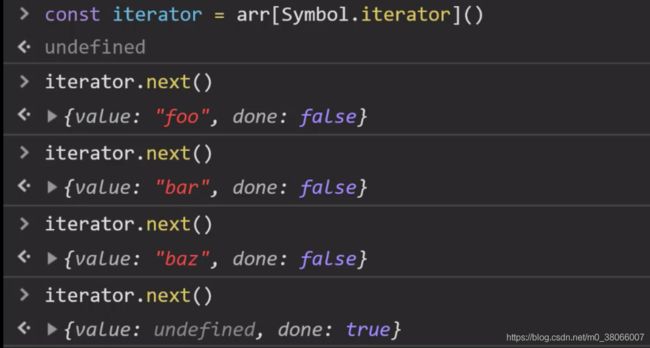Part1-2-1 ECMAScript 新特性
模板字符串标签函数
// 带标签的模板字符串
// 模板字符串的标签就是一个特殊的函数,
// 使用这个标签就是调用这个函数
// const str = console.log`hello world`
const name = 'tom'
const gender = false
function myTagFunc (strings, name, gender) {
// console.log(strings, name, gender)
// return '123'
const sex = gender ? 'man' : 'woman'
return strings[0] + name + strings[1] + sex + strings[2]
}
const result = myTagFunc`hey, ${name} is a ${gender}.`
console.log(result)
Object.assign
将多个源对象中的属性复制到一个目标对象中,
源对象的属性会覆盖掉目标对象的属性
const source1 = {
a: 123,
b: 123
}
const target = {
a: 456,
c: 456
}
const result = Object.assign(target, source1)
console.log(target) // { a: 123, c: 456, b: 123 }
console.log(result === target) // true
Proxy 对象
const person = {
name: 'zce',
age: 20
}
const personProxy = new Proxy(person, {
// 监视属性读取
get (target, property) {
return 100
},
})
personProxy.age = 100
console.log(personProxy.name) // 100const person = {
name: 'zce',
age: 20
}
const personProxy = new Proxy(person, {
// 监视属性读取
get (target, property) {
return property in target ? target[property] : 'default'
},
// 监视属性设置
set (target, property, value) {
console.log(target, property, value) // { name: 'zce', age: 20 } gender true
}
})
personProxy.age = 100
personProxy.gender = true
console.log(personProxy.name) // zce
console.log(personProxy.xxx) // default
Proxy 对比 Object.defineProperty()
优势1:Proxy 可以监视读写以外的操作
const person = {
name: 'zce',
age: 20
}
const personProxy = new Proxy(person, {
deleteProperty (target, property) {
console.log('delete', property) // delete age
delete target[property]
}
})
delete personProxy.age
console.log(person) // { name: 'zce' }
优势2:Proxy 可以很方便的监视数组操作
Object.defineProperty() 对于 数组改变自身的方法(如:push)无法监听到
const list = []
const listProxy = new Proxy(list, {
set (target, property, value) {
console.log('set', property, value) // set 0 100
target[property] = value
return true // 表示设置成功
}
})
listProxy.push(100)
优势3:Proxy 是以非侵入的方式监管了对象的读写
const person = {}
Object.defineProperty(person, 'name', {
get () {
console.log('name 被访问')
return person._name
},
set (value) {
console.log('name 被设置')
person._name = value
}
})
Object.defineProperty(person, 'age', {
get () {
console.log('age 被访问')
return person._age
},
set (value) {
console.log('age 被设置')
person._age = value
}
})
person.name = 'jack'
console.log(person.name)
// Proxy 方式更为合理
const person2 = {
name: 'zce',
age: 20
}
const personProxy = new Proxy(person2, {
get (target, property) {
console.log('get', property)
return target[property]
},
set (target, property, value) {
console.log('set', property, value)
target[property] = value
}
})
personProxy.name = 'jack'
console.log(personProxy.name)
Reflect 对象
Reflect 属于一个静态类
Reflect 内部封装了一系列对对象的底层操作
Reflect 成员方法就是 Proxy 处理对象的默认实现
const obj = {
foo: '123',
bar: '456'
}
// 当对 Proxy 内部方法没有做处理时,等同于调用了 Reflect 对应的内部方法
const proxy = new Proxy(obj, {
get (target, property) {
return Reflect.get(target, property)
}
})
Reflect的意义:统一提供一套用于操作对象的API
const obj = {
name: 'zce',
age: 18
}
// console.log('name' in obj)
// console.log(delete obj['age'])
// console.log(Object.keys(obj))
console.log(Reflect.has(obj, 'name'))
console.log(Reflect.deleteProperty(obj, 'age'))
console.log(Reflect.ownKeys(obj))Set 数据结构
const s = new Set()
s.add(1).add(2).add(3).add(4).add(2)
console.log(s) // Set(4) { 1, 2, 3, 4 }
s.forEach(i => console.log(i)) // 1 2 3 4
for (let i of s) {
console.log(i) // 1 2 3 4
}
console.log(s.size) // 4
console.log(s.has(100)) // false
console.log(s.delete(30)) // true
console.log(s) // Set(3) { 1, 2, 4 }
s.clear()
console.log(s) // Set(0) {}
// 应用场景:数组去重
const arr = [1, 2, 1, 3, 4, 1]
const result = Array.from(new Set(arr))
const result1 = [...new Set(arr)]
console.log(result) // [ 1, 2, 3, 4 ]
console.log(result1) // [ 1, 2, 3, 4 ]
Map 数据结构
// Map 数据结构
const obj = {}
obj[true] = 'value'
obj[123] = 'value'
obj[{ a: 1 }] = 'value'
console.log(Object.keys(obj)) // [ '123', 'true', '[object Object]' ]
console.log(obj['[object Object]']) // value
const m = new Map()
const tom = { name: 'tom' }
m.set(tom, 90)
console.log(m) // Map(1) { { name: 'tom' } => 90 }
console.log(m.get(tom)) // 90
m.forEach((value, key) => {
console.log(value, key) // 90 { name: 'tom' }
})
m.has()
m.delete()
m.clear()
Symbol 数据类型
场景1:扩展对象,属性名冲突问题
以前的做法是约定在属性名前加前缀,例如: a_foo、b_foo
// shared.js ====================================
const cache = {}
// a.js =========================================
cache['foo'] = Math.random()
// b.js =========================================
cache['foo'] = '123'
console.log(cache) // { foo: '123' }
// =========================================================
const s = Symbol()
console.log(s) // Symbol()
console.log(typeof s) // symbol
// 两个 Symbol 永远不会相等
console.log(
Symbol() === Symbol() // false
)
// Symbol 描述文本
console.log(Symbol('foo')) // Symbol(foo)
console.log(Symbol('bar')) // Symbol(bar)
console.log(Symbol('baz')) // Symbol(baz)
// 使用 Symbol 为对象添加用不重复的键
const obj = {}
obj[Symbol()] = '123'
obj[Symbol()] = '456'
console.log(obj) // { [Symbol()]: '123', [Symbol()]: '456' }
// 也可以在计算属性名中使用
const obj1 = {
[Symbol()]: 123
}
console.log(obj1) // { [Symbol()]: 123 }
场景2:Symbol 模拟实现私有成员
以前的做法是 约定在变量名前加 _, 例如:_name、_age
// a.js ======================================
const name = Symbol()
const person = {
[name]: 'zce',
say () {
console.log(this[name]) // zce
}
}
// 只对外暴露 person
// b.js =======================================
// 由于无法创建出一样的 Symbol 值,
// 所以无法直接访问到 person 中的「私有」成员
// person[Symbol()]
person.say()
Symbol 补充
console.log(
Symbol() === Symbol()
) // false
console.log(
Symbol('foo') === Symbol('foo')
) // false
Symbol 全局注册表
const s1 = Symbol.for('foo')
const s2 = Symbol.for('foo')
console.log(s1 === s2) // true
// Symbol 内部维护的注册表 会将 非字符串类型 转成 字符串
console.log(
Symbol.for(true) === Symbol.for('true') // true
)
内置 Symbol 常量
console.log(Symbol.iterator) // Symbol(Symbol.iterator)
console.log(Symbol.hasInstance) // Symbol(Symbol.hasInstance)
const obj = {}
console.log(obj.toString()) // [object Object]
const obj1 = {
[Symbol.toStringTag]: 'XObject'
}
console.log(obj1.toString()) // [object XObject]
Symbol 属性名获取
const obj = {
[Symbol()]: 'symbol value',
foo: 'normal value'
}
for (var key in obj) {
console.log(key) // foo
}
console.log(Object.keys(obj)) // [ 'foo' ]
console.log(JSON.stringify(obj)) // {"foo":"normal value"}
// 以上方法都无法获取 Symbol 类型的属性名
console.log(Object.getOwnPropertySymbols(obj)) // [ Symbol() ]
for...of 循环
作为遍历所有数据结构的统一方式
const arr = [100, 200, 300, 400]
for (const item of arr) {
console.log(item) // 100 200 300 400
}
之前的遍历方式都有一定的局限性
forEach 无法终止遍历, for of 可以 终止遍历
// for...of 循环可以替代 数组对象的 forEach 方法
arr.forEach(item => {
console.log(item)
})
for (const item of arr) {
console.log(item)
if (item > 100) {
break
}
}
// forEach 无法跳出循环,必须使用 some 或者 every 方法
arr.forEach() // 不能跳出循环
arr.some()
arr.every()
for of 可以遍历 Set Map 结构数据
// 遍历 Set 与遍历数组相同
const s = new Set(['foo', 'bar'])
for (const item of s) {
console.log(item) // foo bar
}
// 遍历 Map
const m = new Map()
m.set('foo', '123')
m.set('bar', '345')
for (const item of m) {
console.log(item) // [ 'foo', '123' ] [ 'bar', '345' ]
}
// 可以配合数组解构语法,直接获取 键 值
for (const [key, value] of m) {
console.log(key, value) // foo 123 bar 345
}普通对象不能被直接 for...of 遍历
// 普通对象不能被直接 for...of 遍历
const obj = { foo: 123, bar: 456 }
for (const item of obj) { // TypeError: obj is not iterable
console.log(item)
}可迭代接口(Iterable)
实现 Iterable 接口就是 for of 的前提
以下 可以使用 for of 的数据结构,是因为内部都有一个共同的属性 Symbol(Symbol.iterator)
数组
Set
Map
Symbol.iterator 方法是一个 Iterator 迭代器对象,包含 next 方法
以下是迭代器里 next 方法的内容
说明了在 迭代器 内部维护了一个 数据指针
const set = new Set(['foo', 'bar', 'baz'])
const iterator = set[Symbol.iterator]()
console.log(iterator.next()) // { value: 'foo', done: false }
console.log(iterator.next()) // { value: 'bar', done: false }
console.log(iterator.next()) // { value: 'baz', done: false }
console.log(iterator.next()) // { value: undefined, done: true }
console.log(iterator.next()) // { value: undefined, done: true }
实现可迭代接口(Iterable)
const obj = {
store: ['foo', 'bar', 'baz'],
[Symbol.iterator]: function () {
let index = 0
const self = this
return {
next: function () {
const result = {
value: self.store[index],
done: index >= self.store.length
}
index++
return result
}
}
}
}
for (const item of obj) {
console.log('循环体', item) // 循环体 foo 循环体 bar 循环体 baz
}
// 循环体 foo
// 循环体 bar
// 循环体 baz
迭代器设计模式
// 迭代器设计模式
// 场景:你我协同开发一个任务清单应用
// 我的代码 ===============================
const todos = {
life: ['吃饭', '睡觉', '打豆豆'],
learn: ['语文', '数学', '外语'],
work: ['喝茶'],
// 提供统一遍历访问接口
each: function (callback) {
const all = [].concat(this.life, this.learn, this.work)
for (const item of all) {
callback(item)
}
},
// 提供迭代器(ES2015 统一遍历访问接口)
[Symbol.iterator]: function () {
const all = [...this.life, ...this.learn, ...this.work]
let index = 0
return {
next: function () {
return {
value: all[index],
done: index++ >= all.length
}
}
}
}
}
// 你的代码 ===============================
todos.each(function (item) {
console.log(item)
})
for (const item of todos) {
console.log(item)
}
生成器 Generator 函数
function * foo () {
console.log('zce')
return 100
}
const result = foo()
// 打印的是生成器对象
console.log(result) // Object [Generator] {}
console.log(result.next())
// zce
// { value: 100, done: true }
function * foo () {
console.log('1111')
yield 100
console.log('2222')
yield 200
console.log('3333')
yield 300
}
const generator = foo()
// 第一次调用,函数体开始执行,遇到第一个 yield 暂停
console.log(generator.next())
// 1111
// { value: 100, done: false }
// 第二次调用,从暂停位置继续,直到遇到下一个 yield 再次暂停
console.log(generator.next())
// 2222
// { value: 200, done: false }
// 第三次调用,从暂停位置继续,直到遇到下一个 yield 再次暂停
console.log(generator.next())
// 3333
// { value: 300, done: false }
// 第四次调用,已经没有需要执行的内容了,所以直接得到 undefined
console.log(generator.next())
// { value: undefined, done: true }生成器 Generator 应用
案例1:发号器
// 案例1:发号器
function * createIdMaker () {
let id = 1
while (true) {
yield id++
}
}
const idMaker = createIdMaker()
console.log(idMaker.next().value) // 1
console.log(idMaker.next().value) // 2
console.log(idMaker.next().value) // 3
console.log(idMaker.next().value) // 4
案例2:使用 Generator 函数实现 iterator 方法
// 案例2:使用 Generator 函数实现 iterator 方法
const todos = {
life: ['吃饭', '睡觉', '打豆豆'],
learn: ['语文', '数学', '外语'],
work: ['喝茶'],
[Symbol.iterator]: function * () {
const all = [...this.life, ...this.learn, ...this.work]
for (const item of all) {
yield item
}
}
}
for (const item of todos) {
console.log(item)
}
// 吃饭
// 睡觉
// 打豆豆
// 语文
// 数学
// 外语
// 喝茶
1









